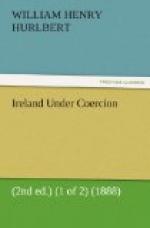The Irish Woollen Company will, nevertheless, be a success, I believe, and a success of considerably more value to Ireland than the election of Mr. Wilfrid Blunt as M.P. for Deptford would be.
As to this election, Mr. Davitt seems to feel no great confidence. He has spoken in support of Mr. Blunt’s candidacy, and is hard at work now to promote it. But he is not sanguine as to the result, as on all questions, save Home Rule for Ireland, Mr. Blunt’s views and ideas, he thinks, antagonise the record of Mr. Evelyn and the local feeling at Deptford. I was almost astonished to learn from Mr. Davitt that Mr. Blunt, by the way, had told him at Ballybrack, long before he was locked up, how Mr. Balfour meant to lock up and kill four men, the “pivots” of the Irish movement, to wit, Mr. O’Brien, Mr. Harrington, Mr. Dillon, and Mr. Davitt himself. But I was not at all astonished to learn that Mr. Blunt told him all this most seriously, and evidently believed it.
“How did you take it?” I asked.
“Oh, I only laughed,” said Mr. Davitt, “and told him it would take more than Mr. Balfour to kill me, at any rate by putting me in prison. As for being locked up, I prefer Cuninghame Graham’s way of taking it, that he meant ‘to beat the record on oakum!’”
If all the Irish “leaders” were made of the same stuff with Mr. Davitt, the day of a great Democratic revolution, not in Ireland only, but in Great Britain, might be a good deal nearer than anything in the signs of the times now shows it to be. Mr. Parnell and the National League are really nothing but the mask of Mr. Davitt and the Land League. Mr. Forster knew what he was about when he proclaimed the Land League in October 1881, six months or more after he had arrested and locked up Mr. Davitt in Portland prison. This was shown by the foolish No-Rent manifesto which Mr. Parnell and his associates issued from Kilmainham shortly after their incarceration, and without the counsel or consent at that time of Mr. Davitt—a manifesto which the Archbishop of Cashel, despite his early sympathies and connection with the agrarian agitation of 1848, found it expedient promptly to disavow. It would have been still more clearly shown had not Mr. Gladstone and Mr. Forster parted company under the restiveness of Mr. Gladstone’s Radical followers, and the pressure of the United States Government in the spring of 1882. But after the withdrawal of Mr. Forster, and the release of Mr. Davitt, the English lawyers and politicians who led Lord Spencer and Sir George Trevelyan into allowing the Land League to be revived under the transparent alias of the National League, gave Mr. Davitt an opportunity, of which he promptly availed himself, to regain the ground lost by the blundering of the men of Kilmainham. From that time forth I have always regarded him as the soul of the Irish agitation, of the war against “landlordism” (which is incidentally, of course, a war against the English influence in Ireland), and of the movement towards Irish independence. Whether the agitation, the war, and the movement have gone entirely in accordance with his views and wishes is quite another matter.




